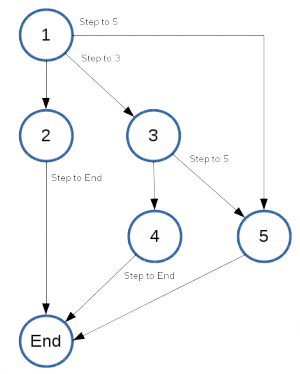Controlling the flow of questions
Overview
The order in which you define the questions of a campaign determine the natural order in which the user answers them. However, it does not always make sense to ask all the defined questions. This is usually the case of questions that depend on how the user answered a previous question.
For instance, consider a campaign that holds the two following questions:
A single answer question Do you need a cloud storage service for sharing your work?, with possible outcomes Yes or No.
A multiple answer question Select the cloud storage services that you prefer, with possible choices Dropbox, Google Drive, Microsoft OneDrive, etc.
It is obvious that users who answered No to the first question will find the second question superfluous or even annoying. In this particular example, you can avoid the situation simply by removing the first question and adding a default choice to the second question: I do not need a cloud storage service. In more complex scenarios, however, you may really want to jump over a question or two when the situation requires it.
Specifying your question flow
There are two ways to alter the order of the questions in a campaign and both are based on the same mechanism: the step to option. A step to declaration indicates the campaign that the normal flow of questions is modified. Instead of asking the user the next question in the defined order, the campaign shall jump to the question specified in the step to option. It is also possible to specify a direct jump to the end of the campaign, if there are no pertinent questions left.
The two ways of altering the order of the questions in a campaign refer to the places where you can apply the step to option. These are the following:
A particular choice of either a single answer or opinion scale question.
The end of the question.
By applying a step to option to individual choices, you create branches in the question flow. Note however that you cannot apply a step to option to the choices of multiple answer questions. Indeed, it would be difficult for a campaign to decide which question to jump to if a user selects two or more choices of a multiple answer question and each choice specifies a different step to option.
Step to options at the end of a question are generally used to merge the different branches generated by individual choices. For single answer and opinion scale questions, the step to options of individual choices take precedence over the step to option declared at the end of the question. This is explicitly stated in the Finder with the message If not specified above, step to when declaring the step to option at the end of a single answer or opinion scale question. For multiple answer questions, the message just reads Step to, since you cannot have individual step to options for each choice.
Thus, when creating a campaign, define your questions in the order that you find the most natural. Then, for each choice that should create a path which deviates from the natural order, set a step to option. Finally, merge different paths back into one by jumping from the end of questions in distinct paths to a common question (or to the end of the campaign).
You will end up with a workflow that, if depicted, should resemble the following diagram.

Note that workflows can help you reduce the number of questions that you ask in a campaign. In the example workflow above, for instance, users will answer at most three questions out of the five questions defined.
Displaying workflows in devices with outdated Collectors
For end-users with versions of the Collector prior to 6.8 installed in their devices, campaigns may be displayed only if they have no step to options defined or not be displayed at all. See the article on the display compatibility of the Collector with campaigns for specific support information by a particular version of the Collector.
RELATED TASK
RELATED REFERENCE
.png)